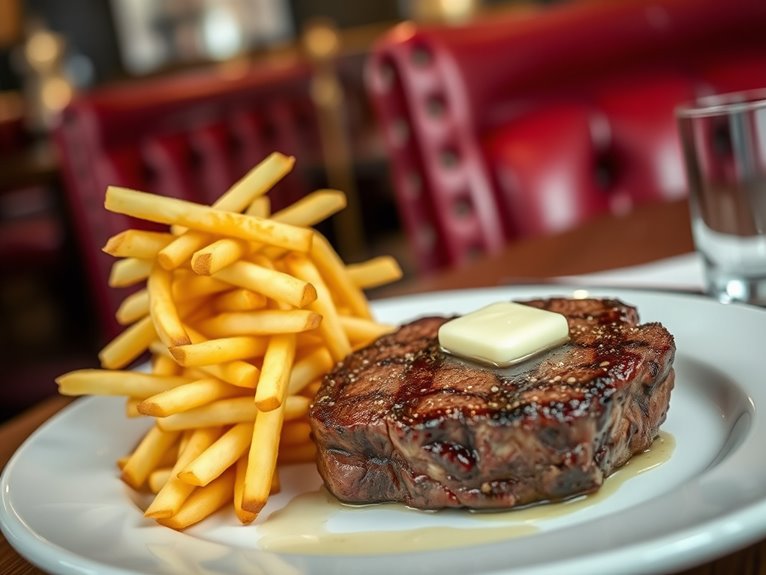
8 Best Places for Authentic Steak Frites in Paris
For the ultimate steak-frites in Paris, I've found eight exceptional spots that'll make your taste buds sing! Le Relais De L'entrecôte leads the pack with their secret 20-ingredient sauce, while Bistrot Paul Bert offers premium hand-cut frites. Don't miss Le Severo's intimate 28-seat experience or L'Ami Louis's decadent duck fat frites. Café de Paris rounds out my top picks with their legendary butter sauce. Want to know my insider tips for ordering like a true Parisian?
What Makes the Perfect Steak-Frites?
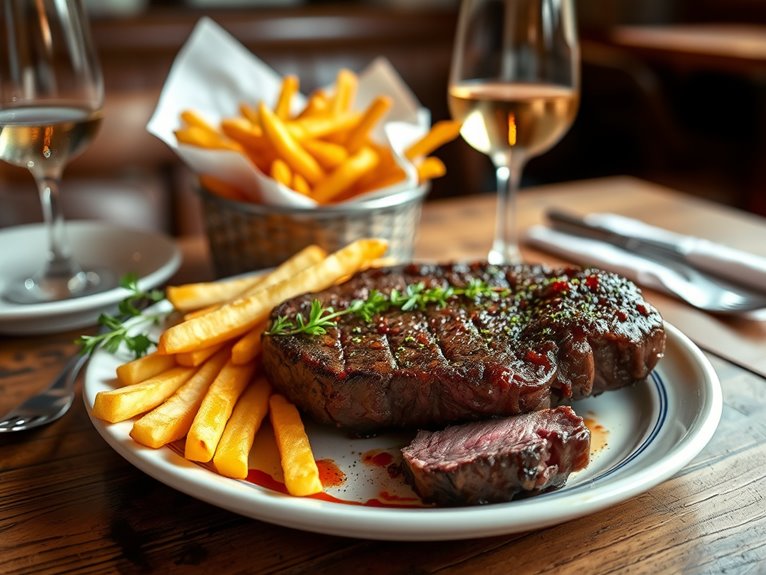
What Makes the Perfect Steak-Frites?
The quintessential Parisian bistro dish, steak-frites represents the perfect marriage of succulent beef and crispy, golden fries. This seemingly simple pairing demands exacting standards and precise execution to achieve its full potential, making it one of the most beloved yet challenging classics in French cuisine.
Understanding what elevates steak-frites from good to exceptional requires exploring multiple elements, from the quality and cut of the meat to the precise double-frying technique for the perfect frites. This iconic dish embodies the French commitment to excellence in seemingly simple preparations, where each component must achieve perfection to create a harmonious whole.
Quick Facts:
- Typical price range: €18-35 in traditional bistros
- Best cut: Entrecôte (ribeye) or contre-filet (sirloin)
- Standard cooking temps: Bleu, saignant, à point, bien cuit
- Traditional accompaniment: Béarnaise sauce or café de Paris butter
- Peak dining hours: 7:30-9:30 PM
- Dietary notes: Generally not available well-done in traditional establishments
The Perfect Steak:
The ideal steak for this dish should be a high-quality cut, typically entrecôte, aged for at least 21 days. The meat should be cooked on high heat to develop a caramelized crust while maintaining a tender, pink center. Traditional French preparations favor saignant (rare) or à point (medium-rare), allowing the meat's natural flavors to shine through.
The Perfect Frites:
Authentic French frites require a specific potato variety (typically Bintje or Maris Piper) and a double-frying process. The first fry at 325°F (163°C) cooks the interior, while the second at 375°F (190°C) creates the signature golden-brown exterior. The result should be crispy outside, fluffy inside, and never greasy.
The Perfect Sauce:
While some purists prefer their steak-frites with nothing more than good butter and fleur de sel, traditional accompaniments include either béarnaise sauce or café de Paris butter. The sauce should complement rather than overwhelm the meat's natural flavors.
Pro Tips:
For the ultimate steak-frites experience, timing is essential. The steak should rest for precisely 5-7 minutes after cooking, while the frites should be served immediately after their final frying. This guarantees ideal temperature and texture for both components. Request your meat one temperature below your usual preference, as French cooking temperatures run slightly rarer than in other countries.
Practical Advice:
When ordering in Paris, specify your desired cooking temperature using French terms (bleu, saignant, à point, bien cuit) to avoid confusion. Most traditional bistros serve steak-frites during both lunch and dinner service, but quality is often best during peak dinner hours when the kitchen is in full swing and the frites are being prepared continuously.
Le Relais De L'entrecôte: the Single-Dish Master
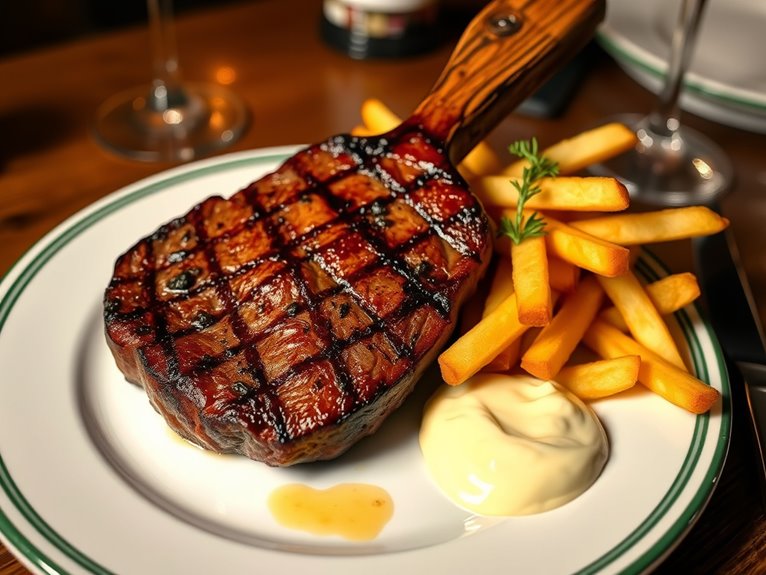
At the heart of Paris's culinary landscape stands Le Relais De L'entrecôte, a restaurant that has elevated the art of steak-frites to legendary status. This iconic establishment, which opened its first location in 1959, has perfected a single dish – perfectly cooked entrecôte (ribeye steak) served with their secret sauce and crispy French fries.
What makes this restaurant truly remarkable is its unwavering commitment to doing one thing exceptionally well. There's no menu to ponder – guests are simply asked how they'd like their steak cooked, and the experience unfolds from there. The signature sauce, a closely guarded family recipe rumored to contain herbs, mustard, and over 20 ingredients, has become the stuff of culinary legend.
Quick Facts:
- Price Range: €29.50 for the complete meal (includes salad, two servings of steak-frites, dessert extra)
- Reservations: Not accepted – first come, first served
- Wait Times: 30-60 minutes during peak hours
- Dietary Restrictions: No vegetarian options available
- Payment Methods: Cash and major credit cards
- Three locations: Saint-Germain, Montparnasse, and Marbeuf
Location Details:
The original Saint-Germain location (20 Rue Saint-Benoît) remains the most sought-after, situated in a charming art deco building with classic Parisian atmosphere. Operating hours are 12:00-14:30 for lunch and 19:00-23:30 for dinner, seven days a week. The restaurant's efficiency is remarkable – tables turn quickly, and the no-reservation policy keeps the experience democratic and accessible to all.
Insider's Secret: While many diners don't realize it, each meal includes two servings of steak-frites. The kitchen deliberately serves half your portion initially, keeping the second half warm to maintain ideal temperature and texture when served. Wait staff will appear with the second serving just as you're finishing your first.
Pro Tips:
To minimize wait times, arrive either right at opening (12:00 for lunch, 19:00 for dinner) or during off-peak hours (14:00 for lunch, 22:00 for dinner). The restaurant is known for its swift service, so even with a queue, the wait is usually manageable. Locals often grab an aperitif at nearby cafés while waiting for their table.
Practical Advice:
Given the restaurant's popularity and no-reservation policy, plan your visit strategically. The Montparnasse location tends to be less crowded than Saint-Germain, making it a smart choice during peak tourist season. Keep in mind that portions are generous, so consider skipping lunch if you're planning a dinner visit. The wine list, while not extensive, is well-curated to complement the steak-frites, with house wines offering excellent value.
Bistrot Paul Bert: Time-Honored Tradition
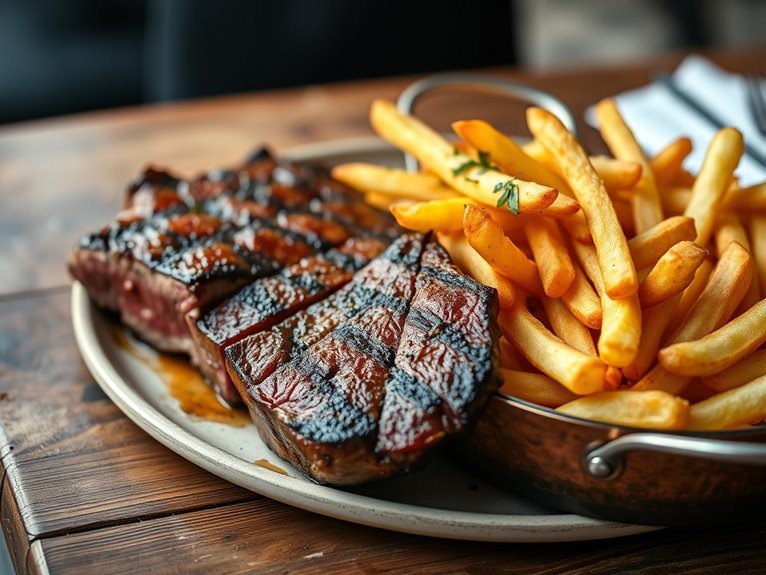
Nestled in the 11th arrondissement, Bistrot Paul Bert stands as a symbol of authentic Parisian dining, where the time-honored tradition of steak-frites has been perfected over decades. This cherished establishment, opened in 1997, has become a pillar of French gastronomy, drawing both locals and tourists seeking the quintessential bistrot experience.
The restaurant's commitment to preserving traditional French cuisine while maintaining exacting standards has earned it a reputation as one of Paris's finest destinations for steak-frites. Their signature dish features a perfectly cooked entrecôte paired with hand-cut frites, served with their renowned pepper sauce that has become the stuff of culinary legend.
Quick Facts:
- Price Range: €38-45 for steak-frites
- Reservations: Essential, especially for dinner (book 2-3 weeks ahead)
- Hours: Tuesday-Saturday, 12:00-14:00 and 19:30-23:00
- Dress Code: Smart casual
- Dietary Options: Limited vegetarian options
- Wine List: Extensive French selection, sommelier available
The Classic Steak-Frites Experience:
The cornerstone of Bistrot Paul Bert's menu is their steak-frites, featuring premium beef sourced from select French butchers. The steak is cooked precisely to order on a well-seasoned grill, developing a perfect crust while maintaining tenderness inside. The accompanying frites are double-fried to achieve the ideal combination of crispy exterior and fluffy interior. Insider tip: Request "sauce au poivre à part" (pepper sauce on the side) to control the intensity of the peppery kick.
Pro Tips:
For the ultimate dining experience, arrive for the first dinner service at 19:30 when the kitchen is fresh and energetic. Request a table in the main dining room rather than the annex to soak in the authentic bistrot atmosphere. Consider ordering your steak one temperature below your usual preference, as French cooking temperatures tend to run slightly rarer than in other countries.
Practical Advice:
Always confirm your reservation the day before, and arrive on time as tables are typically allocated for specific time slots. French is the primary language, but most staff speak basic English. Credit cards are accepted, but having some cash on hand is recommended for smaller amounts. The restaurant is a 5-minute walk from the Faidherbe-Chaligny metro station (Line 8).
Le Severo: A Butcher's Approach to Steak
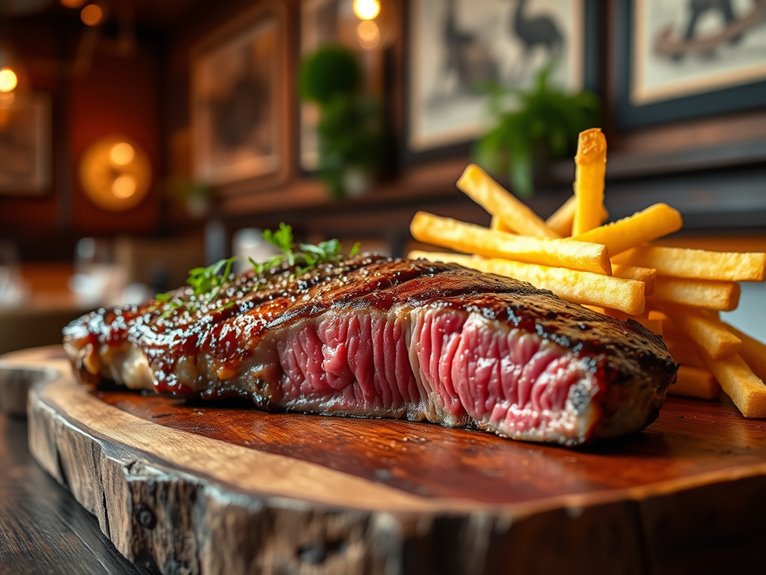
Tucked away in the 14th arrondissement, Le Severo represents the pinnacle of Paris's steak-frites culture, distinguished by its owner William Bernet's background as a master butcher. This intimate bistro has earned its reputation by focusing on exceptional meat quality and precise preparation techniques, making it a must-visit destination for serious steak enthusiasts.
What sets Le Severo apart is its unwavering commitment to sourcing and aging premium cuts of beef. Bernet personally selects each cut, drawing upon his extensive butchery expertise to guarantee only the finest meat makes it to the restaurant's plates. The establishment's dedication to authenticity and simplicity has attracted both locals and international food critics who praise its perfectly executed steak-frites.
Quick Facts:
- Price Range: €32-45 for main courses
- Reservations: Essential, book at least 2 weeks in advance
- Hours: Tuesday-Saturday, 12:00-2:30pm and 7:00-10:30pm
- Dietary Restrictions: Limited vegetarian options
- Wine List: Extensive, focusing on robust reds
- Seating Capacity: 28 seats
- Dress Code: Smart casual
The Signature Experience
Le Severo's star attraction is their entrecôte, a perfectly marbled ribeye that undergoes careful aging before being cooked to order on a well-seasoned grill. The steak is served with crispy, hand-cut frites and a simple green salad. The meat speaks for itself, seasoned only with salt and pepper, allowing the natural flavors to shine. Insider tip: Request your steak one level rarer than you typically prefer, as French cooking temperatures run slightly higher than international standards.
Pro Tips:
The prime dining experience at Le Severo comes with strategic timing and ordering. Book a table for 7:30 PM to catch the kitchen at its peak performance while avoiding the main dinner rush. While the menu offers various cuts, the house specialty is the entrecôte frites, best paired with a bottle from their carefully curated selection of Bordeaux wines. Ask the owner for his personal wine recommendations – he's known for suggesting perfect matches based on your meat selection and preferences.
Practical Advice:
Located at 8 Rue des Plantes, the restaurant is accessible via Metro line 13 (Pernety station). Given the intimate size and popularity, punctuality for reservations is vital. Payment methods include major credit cards, but having some cash on hand is recommended. The restaurant maintains a strict no-substitutions policy on their signature dishes, reflecting their commitment to serving each item as intended by the chef. English-speaking staff is available, but having basic French phrases ready will enhance the authentic Parisian bistro experience.
Café De Paris: the Original Butter Sauce
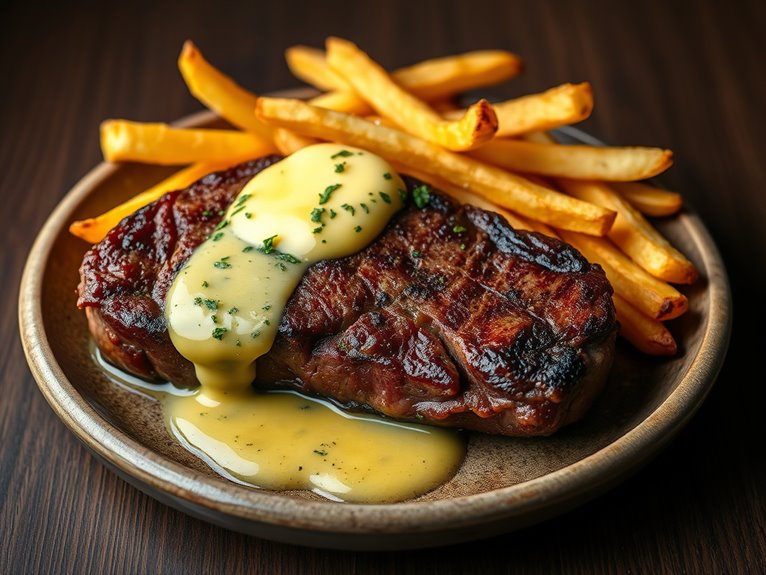
The legendary Café de Paris butter sauce represents one of the most closely guarded culinary secrets in French cuisine, originating from the historic Café de Paris restaurant in Geneva but achieving its greatest fame in Paris's steakhouse culture. This complex compound butter sauce, featuring a blend of herbs, spices, and aromatics, transforms a simple steak-frites into an unforgettable dining experience that has captivated food enthusiasts for generations.
While many Parisian restaurants claim to serve authentic Café de Paris sauce, the original recipe remains a carefully protected secret, with only a handful of establishments maintaining the true traditional preparation method. The sauce's distinctive orange-golden color and its ability to complement both the meat and the crispy frites has made it an essential element of the Parisian steakhouse experience.
Quick Facts:
- Price Range: €25-45 for steak-frites with authentic Café de Paris sauce
- Best Time to Order: Dinner service (7:00 PM – 10:30 PM)
- Dietary Considerations: Contains dairy, may include anchovy
- Reservation Recommended: Yes, especially at authentic venues
- Typical Serving Style: Served melting over hot steak
- Temperature: Always served warm, never cold or completely melted
The Classical Preparation:
The authentic Café de Paris butter sauce requires over 30 ingredients and a precise preparation method that takes several hours. The base starts with high-quality French butter, combined with herbs like thyme and marjoram, spices including paprika and curry powder, and aromatics such as shallots and garlic. The sauce must be prepared in advance and meticulously heated to achieve the perfect consistency when served over the hot steak.
Insider Tip: True Café de Paris sauce should never be completely liquid; it should maintain a creamy, emulsified consistency that slowly melts over the hot meat.
Pro Tips:
The best way to experience Café de Paris sauce is to let it melt gradually over your steak rather than stirring it in immediately. This allows the flavors to develop and guarantees each bite offers a perfect balance of meat and sauce. Request your steak cooked slightly less than you typically prefer, as the hot sauce will continue to cook the meat slightly when served.
Practical Advice:
When seeking authentic Café de Paris sauce in Paris, look for establishments that prepare the sauce fresh daily and serve it in the traditional manner – with the sauce placed atop the steak immediately before serving. Avoid restaurants that offer the sauce as a side option or serve it completely melted, as these are typically not preparing the authentic version. For the best experience, pair the dish with a robust red wine, preferably a Bordeaux or Côtes du Rhône, which complements both the rich sauce and the beef.
L'Ami Louis: Celebrity's Choice Since 1924
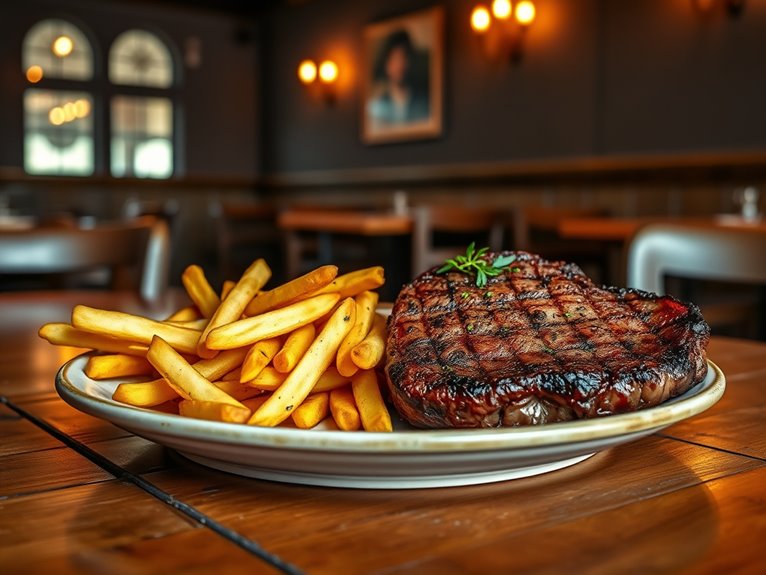
Best Places for Steak Frites in Paris: L'Ami Louis
Celebrity's Choice Since 1924
Tucked away in the 3rd arrondissement, L'Ami Louis stands as a tribute to Parisian culinary tradition, serving what many consider the city's finest steak frites for nearly a century. This unpretentious bistro has attracted everyone from presidents to Hollywood stars, all drawn by its perfectly executed classic dish and steadfast refusal to bow to modern dining trends.
The restaurant's weathered zinc bar, vintage light fixtures, and well-worn wooden tables tell the story of countless memorable meals shared within its walls. While tourists now mix with locals in its cozy dining room, L'Ami Louis maintains the same exacting standards for its signature dish that made it famous: prime cuts of beef seared to perfection and paired with hand-cut fries cooked in duck fat.
Quick Facts:
- Price Range: €€€€ (Steak frites approximately €98)
- Reservations: Essential, book 2-3 months in advance
- Hours: Tuesday-Saturday, 12:00-14:30 and 19:00-23:00
- Dress Code: Smart casual
- Payment: Cash and major credit cards accepted
- Languages: French primary, limited English
- Dietary Restrictions: Limited vegetarian options
The Signature Experience:
L'Ami Louis's steak frites comes from carefully selected cuts of entrecôte, grilled over open flames and served with a mountain of their legendary frites. The meat arrives with a perfectly caramelized crust while maintaining requested doneness inside. The frites, twice-cooked in duck fat, achieve the ideal balance of crispy exterior and fluffy interior. Location: 32 Rue du Vertbois, 75003 Paris. Insider tip: Request a table in the front room near the kitchen for the most authentic atmosphere and the chance to watch the culinary theater unfold.
Pro Tips:
The best experience at L'Ami Louis comes with timing and patience. Book the first dinner seating at 19:00 to enjoy the most attentive service and freshest preparation. Don't rush – a proper meal here typically takes two to three hours. Order your steak one degree rarer than you typically prefer, as the meat continues to cook slightly on the hot plate.
Practical Advice:
Despite its celebrity clientele, L'Ami Louis maintains a decidedly casual, sometimes brusque service style typical of traditional Parisian bistros. Prices are exceptionally high for what appears to be simple fare, but the portion sizes are generous enough to share. Bring cash as a backup payment method, and don't be surprised if the menu is presented only in French – the waitstaff can help explain options, though they may seem reluctant at first.
Tips for Ordering Steak-Frites Like a Local
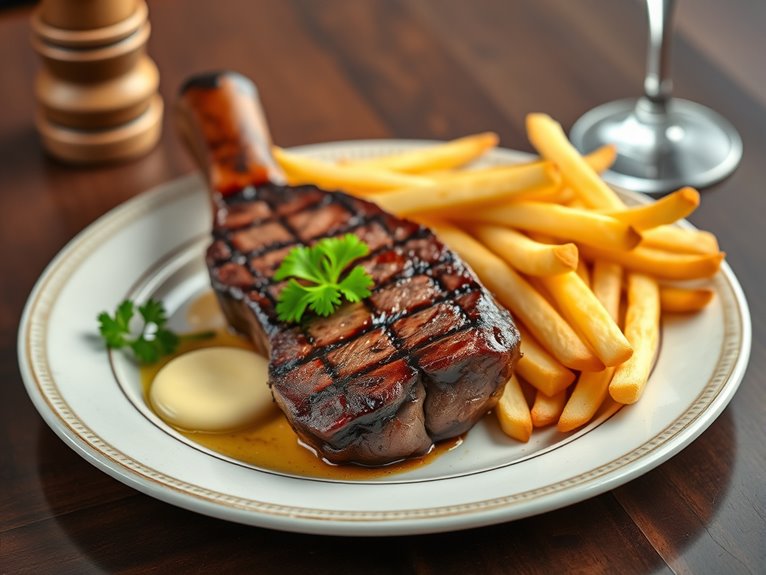
The iconic steak-frites is more than just a meal in Paris – it's a cultural institution that requires a certain savoir-faire to order and enjoy properly. While seemingly straightforward, this classic bistro dish comes with its own set of unwritten rules and customs that can make the difference between a tourist experience and an authentic Parisian dining moment.
Mastering the art of ordering steak-frites helps you blend in seamlessly with locals while guaranteeing you get exactly what you're looking for regarding preparation and service. From understanding cooking temperatures to knowing when to request sauce on the side, these insider tips will elevate your dining experience and help you navigate the sometimes intimidating world of Parisian bistros.
Quick Facts:
- Typical price range: €18-35 for classic bistro versions, €35-60 for premium cuts
- Peak dining hours: 12:30-2:00 PM for lunch, 8:00-10:00 PM for dinner
- Reservations: Recommended for dinner, especially at popular establishments
- Standard portion size: 200-250g of meat with unlimited frites at many places
- Common cooking temperatures: Bleu, Saignant, À Point, Bien Cuit
The Language of Ordering
Start by mastering essential French terms for steak preparation. "Saignant" (rare) is the most traditional and recommended way to enjoy your steak, while "à point" (medium) is acceptable. Never order "bien cuit" (well done) unless you want disapproving looks from your server. Insider tip: If you're unsure, ask for "comme le chef le recommande" (as the chef recommends).
Sauce Etiquette
Traditional steak-frites comes with a specific sauce, usually béarnaise or herb butter. While it's acceptable to request sauce on the side, avoid asking for substitutions or additional sauces – it's considered somewhat gauche. Insider tip: Many locals enjoy starting with the steak alone and gradually incorporating the sauce throughout the meal.
Timing Your Order
Unlike many cultures, the French typically eat their main courses in sequence rather than all at once. Order your steak-frites as "plat principal" (main course) after your starter, if having one. This guarantees your steak arrives at the best temperature and your frites remain crispy.
Pro Tips:
The best steak-frites experiences often come from smaller neighborhood bistros rather than tourist-heavy establishments. Look for places where locals are dining, and don't be afraid to ask your server for recommendations on preparation. Many regular patrons develop relationships with specific bistros and even have their preferred tables – showing respect for these traditions will earn you better service and possibly insider treatment.
Practical Advice:
Always confirm your desired cooking temperature while ordering, as French temperature scales differ slightly from American or British standards. Keep in mind that most Parisian bistros won't accommodate special requests for cooking methods or extensive modifications to the dish. Embrace the traditional preparation – it's part of the authentic experience. Have cash on hand as some smaller establishments may not accept all cards, and remember that tipping, while appreciated, is more modest in France (5-10% is standard for good service).
Best Wine Pairings for Your Steak-Frites Experience
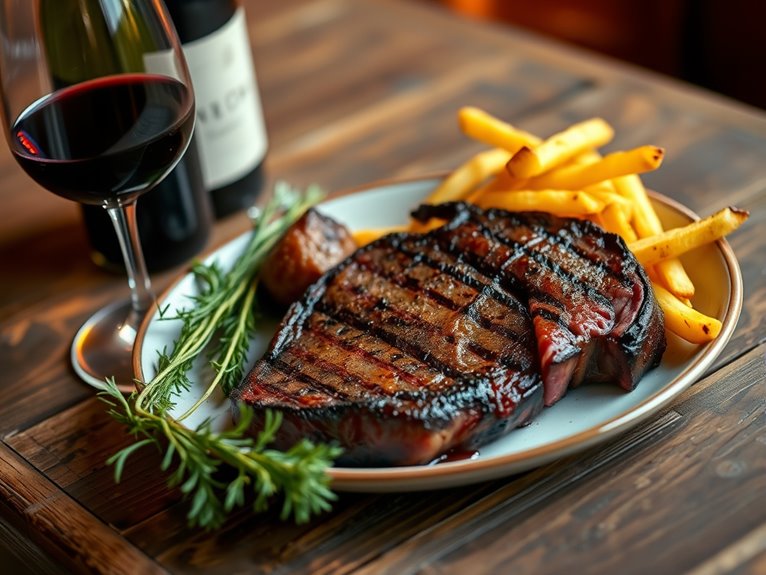
The classic Parisian steak-frites experience reaches new heights when paired with the perfect French wine. This beloved bistro dish, featuring a juicy steak alongside crispy golden frites, creates an ideal canvas for exploring France's diverse wine regions and varietals.
Understanding the art of wine pairing with steak-frites not only enhances your dining experience but also provides an authentic glimpse into French gastronomy. The right wine can complement the meat's rich flavors while cutting through its fattiness, creating a harmonious balance that elevates both the food and the wine.
Quick Facts:
- Wine prices in Parisian bistros: €25-150 per bottle, €6-15 per glass
- Most restaurants offer wine by both bottle and glass
- Sommelier service available at higher-end establishments
- Temperature-controlled storage guarantees optimal serving conditions
- Decanting available upon request at most venues
Classic Red Bordeaux
The traditional choice for steak-frites, Bordeaux reds offer structured tannins and dark fruit notes that complement the meat's richness. Focus on Left Bank Bordeaux blends, particularly from Médoc or Saint-Julien. These wines typically feature Cabernet Sauvignon-dominant blends that stand up beautifully to a perfectly cooked steak. Insider tip: Ask for wines from the 2015 or 2016 vintages, which are drinking beautifully now and widely available.
Northern Rhône Syrah
Syrah from regions like Côte-Rôtie or Hermitage provides pepper notes and smoky characteristics that enhance the steak's char. These wines offer impressive complexity with black fruit, olive, and leather notes. The natural acidity helps cut through the richness of the meat while complementing the crispy frites. Insider tip: Look for smaller producers like Jean-Louis Chave for exceptional value compared to bigger names.
Burgundy Pinot Noir
For those preferring leaner cuts or steaks cooked medium-rare, a mature Burgundy Pinot Noir offers elegance and subtle power. Focus on wines from the Côte de Nuits, particularly from villages like Gevrey-Chambertin or Nuits-Saint-Georges. Insider tip: Many restaurants carry older vintages of village-level wines that offer better value than young premier crus.
Pro Tips:
Don't hesitate to ask the sommelier for guidance, as they often know of hidden gems on their list that perfectly match their kitchen's preparation style. Temperature matters greatly – request your red wine be served slightly below room temperature (around 16-18°C) for optimal enjoyment. If dining solo or as a couple, consider ordering by the glass to experience different pairings throughout your meal.
Practical Advice:
Reserve your table for later in the evening (after 8:00 PM) when Parisian restaurants are fully operational and wine service is at its peak. Most establishments store their wines properly, but if you select a special bottle, allow it to breathe for 15-30 minutes before enjoying. Always confirm the vintage being served matches what's listed on the menu, as substitutions occasionally occur.
